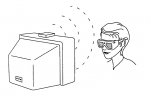Lenny Lipton, founder of Stereographics and former CTO of RealD, talks in his blog in a not so humble series of articles [Part 1, Part 2] about the invention of the Crystaleyes shutterglasses :


The basic concept of shuttering eyewear for viewing stereoscopic images isn’t mine. You can find mentions of it in the literature before my work began. Missing from the early work were the elegant electro-optical shutters that we now have and a good communications link between the display and the eyewear. (…)
I founded StereoGraphics Corporation in 1980 for the specific purpose of developing stereoscopic technology and offering products to industry. (…)
The initial StereoGraphics products used tethered or wired eyewear for viewing a CRT monitor. We needed to modify the monitors to run at a high field rate. (…) We wound up making motherboards that were introduced into monitors to goose them into running at 120 fields per second. We took the sync pulse from the video signal and used that to tell our tethered eyewear when to shutter. (…) The result was a decent stereoscopic image, but the shutters used pretty high voltage (200-300 volts), had low transmission, had parallel electrodes running through them and made an odd buzzing sound that wasn’t exactly comforting close to your eyeballs.
[Insert here *very* technical information about how they created the LCD glass that will allow the light to pass or not]I knew that the ultimate package would be one that would not involve any cables or wires, or a big controller the size of a hi-fi amplifier. But how to fit everything into a pair of eyewear?? [Insert very technical information about lowering the power needs of the LCD system] (…)
(…) I became one of the first people to use optical compensation to improve the performance of liquid crystal parts. This allowed us to leap from a 15:1 dynamic range to one of more than 800:1. (…)
Marv Ackerman designed the infrared link using a pulse width modulation scheme to designate the left from the right fields and to make sure that the shutters were in phase.
The marketing of CrystalEyes was an example of the sale of vaporware. We presold the concept by allowing Silicon Graphics to believe that they invented it. (…) Six months later at SIGGRAPH we showed the first CrystalEyes.  If Jim Clark [one of the founders of Silicon Graphics] had thought about it at all he would have realized that it was impossible to have put anything like CrystalEyes together in six months.
We got them just in time for SIGGRAPH. I was in my hotel room at the convention assembling them with a little jeweler’s screwdriver, slaving away putting them together. We got enough of them to work and got orders for hundreds and hundreds of them from Silicon Graphics. They wanted them in their color with their brand, and we were happy to comply.  In no time at all SGI ate Evan&Sutherland’s lunch with their computer and molecular modeling applications.
We sold over a hundred thousand Crystal Eyes to people in fields like molecular modeling, aerial mapping, oil and gas exploration, and CAD over a period of something less than 20 years. I believe millions of shuttering eyewear are now going to be sold for 3D TVs. A great deal of effort has gone into making high-field-rate displays in order to provide sharper images of objects inmotion. So much time and effort to make LCDs look like CRTs.
That high-field rate technology can be applied to stereoscopic field-sequential television using shuttering eyewear. It means that the customer can buy after-market shuttering eyewear, which in turn means that the cost of the set can stay low but the stereo function can be enabled by purchasing the eyewear.
I’m happy to be around to see all of this come to pass. Shuttering eyewear is a good solution for stereoscopic television – providing that people will put up with wearing eyewear at home – because it will become a commodity product, and the end-user at home will be able to buy these eyewear at a low price. And they will get smaller and lighter and eventually be all but indistinguishable from polarizing eyewear.
I didn’t think there was that much research involved. I had imagined that the LCD glass was already existing. So thank you Lenny and your team for giving us my favorite viewing device (after HMDs) !
On a more personnal note, thursday was my last day at Virtools and it was quite moving. But to cheer me up, my colleagues offered me the Fujifilm Finepix Real 3D W1, a stereoscopic camera !! A VR geek come true !! I’ve only played with it for two days but I’m so in love with it.. I’ll try to make a review when I come back from Sri Lanka !
